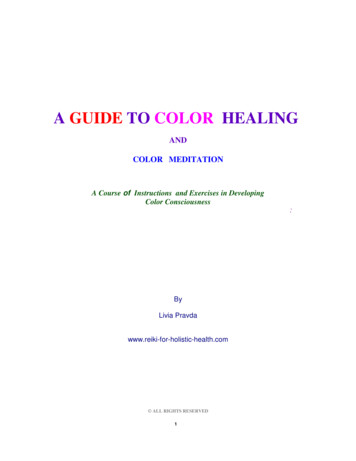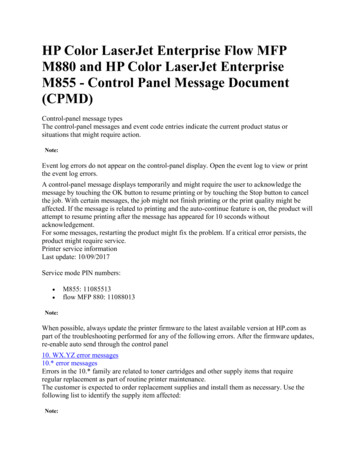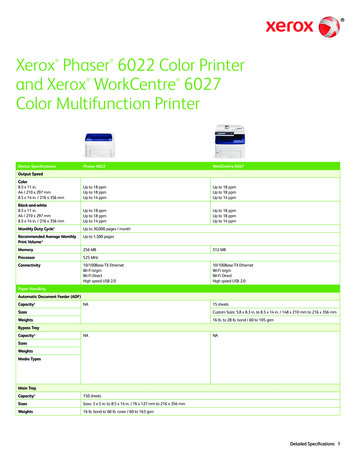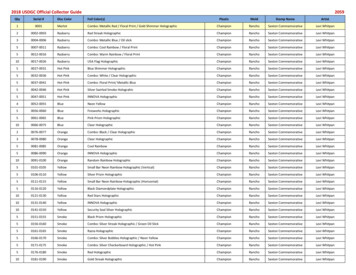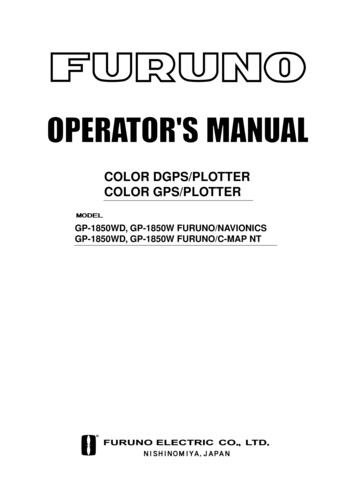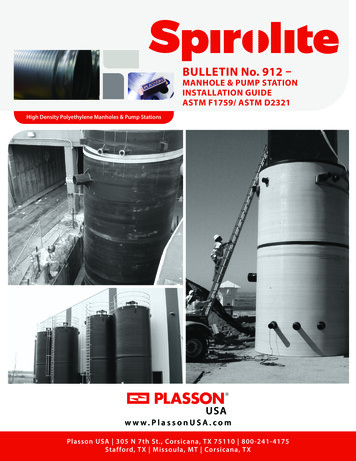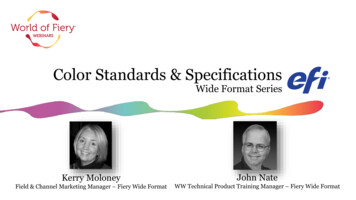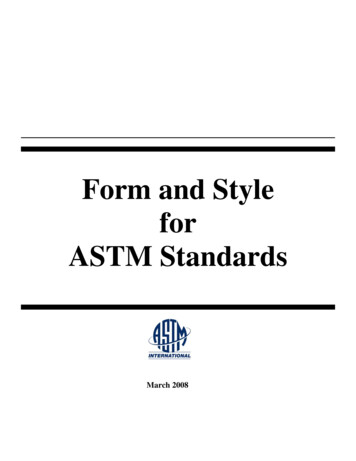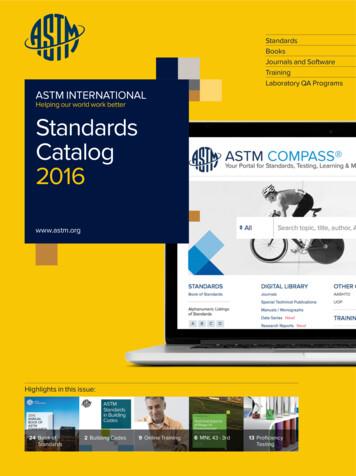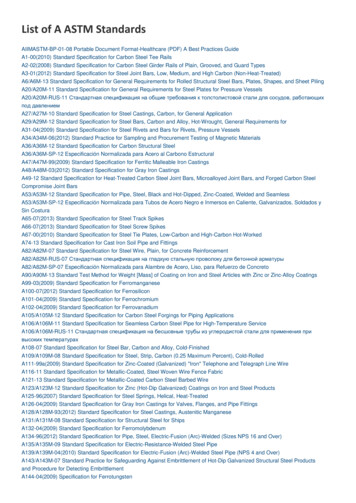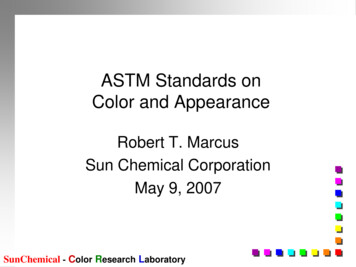
Transcription
ASTM Standards onColor and AppearanceRobert T. MarcusSun Chemical CorporationMay 9, 2007SunChemical - Color Research Laboratory
ASTM InternationalFounded in 1898 One of the largest voluntary standardsdevelopment organizations in the world More than 12,000 standards publishedeach year More than 30,000 technical expertsfrom more than 100 countries 139 technical committees SunChemical - Color Research Laboratory
Committee E12 onColor and AppearanceTo promote knowledge of color andappearance properties andcharacteristics, and to encourage theimprovement and development ofstandards for describing and evaluatingcolor and appearance properties by:SunChemical - Color Research Laboratory
Committee E12 onColor and Appearance* Stimulating and sponsoring research intocolor and appearance problems;* Formulating terms, nomenclature, anddefinitions generally applicable for describingcolor and appearance;SunChemical - Color Research Laboratory
Committee E12 onColor and Appearance* Developing, or coordinating with othertechnical committees to develop standards formeasuring fundamental and generalproperties;* Assisting other technical committees toimprove color and appearance standards andspecifications by advice, suggestions, anddissemination of information;SunChemical - Color Research Laboratory
Committee E12 onColor and Appearance* Reviewing and recommending approval orrevision of ASTM standards, existing orproposed, involving color and appearancefactors;* Serving, with the approval of the ASTMBoard of Directors, as liaison agent betweenthe Society and other organizations in mattersconcerned with factors of color andappearance.SunChemical - Color Research Laboratory
E12 Technical Subcommittees E12.01 on TerminologyE12.02 on Spectrophotometry andColorimetryE12.03 on GeometryE12.04 on Color and Appearance AnalysisE12.05 on FluorescenceE12.06 on Image Based Color MeasurementE12.07 on Color Order SystemsSunChemical - Color Research Laboratory
E12 Technical Subcommittees E12.08 on High Visibility Materials forIndividual SafetyE12.10 on RetroreflectionE12.11 on Visual MethodsE12.12 on Metallic and Pearlescent ColorsE12.13 on Photoluminescent Safety MarkingsE12.14 on Multidimensional Characterizationof AppearanceE12.93 on Precision and BiasSunChemical - Color Research Laboratory
Categories of E12 Standards Terminology Standard Definitions of terms; explanations of symbols;abbreviations; acronymsE284 Standard Terminology of Appearance(E12.01)Guides Informative; series of options that do notrecommend a specific course of actionE2030 Standard Guide for Recommended Uses ofPhotoluminescent (Phosphorescent) SafetyMarkings (E12.13)SunChemical - Color Research Laboratory
Categories of E12 Standards Practices A definitive set of instructions for performing oneor more specific operations that do not produce atest result.E2175 Standard Practice for Specifying theGeometry of Multiangle Spectrophotometers(E12.03)Test Methods A definitive procedure that produces a test result.E1331 Standard Test Method for ReflectanceFactor and Color by Spectrophotometry UsingHemispherical Geometry (E12.02)SunChemical - Color Research Laboratory
Categories of E12 Standards Specifications An explicit set of requirements to be satisfied by amaterial, product, system, or serviceE1501 Standard Specification for NighttimePhotometric Performance of RetroreflectivePedestrian Markings for Visibility Enhancement(E12.08)SunChemical - Color Research Laboratory
Classification and Balance Committees and subcommittees developingstandards dealing with materials, products,systems, or services which are offered forsale are required to be classified andbalanced. Classified subcommittees shallconsist of not less than three producers andnot less than three non-producers.E12 is a classified committeeE12.08 and E12.13 are classifiedsubcommitteesSunChemical - Color Research Laboratory
Classification and Balance Producers A member who represents and organization thatmanufactures, fabricates, sells supplies orpromotes materials, products, assemblies orservices covered by the subcommittee scope.Companies or individuals manufacturinginstruments, light booths or producing softwareused to do color and/or appearance testing.User A member who represents and organization thatpurchases or uses materials products, assembliesor services covered by the subcommittee scope.SunChemical - Color Research Laboratory
Classification and Balance General Interest A member that does not fit into any of thepreceding categories shall be classified as ageneral interest member.SunChemical - Color Research Laboratory
The Process Of Creating A Standard The subcommittee determines the need for anew standard.A task group drafts the standard.The draft is submitted for editorial review.The draft is placed on a subcommittee ballot.Subcommittee members vote on the draft. AffirmativeAffirmative with commentsNegativeAbstainSunChemical - Color Research Laboratory
The Process Of Creating A Standard Negative votes Must be accompanied by an explanation of whythe voter cast the negative vote.Should contain alternative wording that wouldsatisfy the negative voter if incorporated into thedraft.All negative votes must be resolved. Accepted. Changes will be made to the draftFound non-persuasive and changes will not be made.All comments are considered by thesubcommittee but will not prevent the draftfrom going to the next level.SunChemical - Color Research Laboratory
The Process Of Creating A Standard If persuasive negative votes were cast, thedraft is revised and put onto a subcommitteeballot.Once the draft passes a subcommittee ballotwith no negative votes, it is placed onto acommittee ballot.Committee members vote on the draft.Negative votes must be resolved by theoriginating subcommittee.Comments will be reviewed.SunChemical - Color Research Laboratory
The Process Of Creating A Standard If any persuasive negative votes were cast,the draft will be revised and re-balloted.If no persuasive negative votes were cast butnegative votes cast were found to be nonpersuasive by the subcommittee, the nonpersuasive finding must be upheld by theentire committee.The procedure for finding the negative votenon-persuasive will also be reviewed by theASTM Committee on Standards.SunChemical - Color Research Laboratory
The Process Of Creating A Standard All members of ASTM International have theopportunity to review the standard beforepublication and comment or cast a negativevote. Negative votes cast at the ASTM levelmust be resolved before publication of thestandard.When the draft has been reviewed andaccepted at all levels, the draft becomes anASTM standard and is published.Standards may be revised at any timefollowing publication.SunChemical - Color Research Laboratory
Mandatory Review Of Standards A standard must be reviewed by theresponsible subcommittee and balloted forreapproval, revision, or withdrawal within fiveyears of its last approval date.If no action has been taken by January 1st ofthe sixth year, ASTM will automatically ballotthe standard for withdrawal.If the standard has not received a newapproval date by December 31st of the eighthyear since its last approval date, the standardwill be withdrawn by ASTM.SunChemical - Color Research Laboratory
SunChemical - Color Research Laboratory
Scope E12.01 on TerminologySubcommittee E12.01 on Terminology is responsible for theupkeep of E 284, Standard Terminology of Appearance. Thesubcommittee is actively managing this standard to providereliable definitions for terms used in new and revised E12standards and other documents relating to the description ofappearance. Terms relating to perception, gonioappearance,instrument agreement, and fluorescence are of particularinterest at present. Special care is being taken to promoteagreement with the forthcoming revision of the CIE InternationalLighting Vocabulary, and cooperation with the new CIE Division8 on Imaging Technologies is expected to generate additionalopportunities for standardizing terminology relating toappearance.SunChemical - Color Research Laboratory
E12.02 on Spectrophotometry and ColorimetryASTM Subcommittee E12.02 on Spectrophotometry andColorimetry actively maintains ASTM Practices and TestMethods that reflect the current state of the art in instrumentalcolorimetric measurement and assessment. The subcommitteeembraces absolute standards, instrumentation andmeasurement methodologies.SunChemical - Color Research Laboratory
E12.03 on GeometryASTM Subcommittee E12.03 on Geometry is responsible forgeometric aspects of ASTM standards on color andappearance. With respect to appearances, people often say, "Itall depends on how you look at it." In this committee, that is nottaken figuratively, but quite literally. Many materials havedifferent colors, gloss, luster, sheen, or glitter, depending on theangular conditions of illumination and viewing. For this reason,standard methods of viewing materials and standard methods ofmeasuring physical quantities that correlate with visualobservations must specify geometry precisely. Thesubcommittee standardizes concepts, terminology, and notationfor specifying the geometry for viewing and measuring materialsand assists other subcommittees with the geometric aspects ofstandardization.SunChemical - Color Research Laboratory
E12.04 on Color and Appearance AnalysisSubcommittee E12.04 on Color and Appearance Analysis isresponsible for developing and maintaining standard practicesthat involve the numerical or mathematical manipulation of colormeasurement data. These standards include the derivation oftristimulus values, color space coordinates, scales ofyellowness, whiteness, and color differences. Much of theresearch in colorimetry involves the comparison and modeling ofthe objective measurement of light stimuli with the subjectivevisual response to those stimuli. As that research is introducedinto the public domain, this subcommittee attempts to documentand standardize the practical aspects that will improve thecommunication of color across the design, production andmarketing applications. Our standards include E 308 oncomputing the colors of objects by using the CIE System, E1345on reducing the variability of color measurement by use ofmultiple measurements and E 1708 on electronic interchange ofcolor and appearance data.SunChemical - Color Research Laboratory
E12.05 on FluorescenceASTM subcommittee E12.05 on Fluorescence is activelyworking to update the existing standard practices and testmethods to reflect the current state of the art for the colorimetryof fluorescent materials. There is a major revision of ASTM E1247 on identifying fluorescence in object-color specimens inprogress. The subcommittee is also working on thedevelopment of new standards including: a proposed guide tofluorescence and the colorimetry of fluorescent materials thatcan be used as reference by industry to understand whatfluorescence really is and the issues involved in the accurateand reproducible color measurement of these materials, and aproposed method for the measurement of fluorescent materialsusing the two-monochromator method. The objective of thismethod is to describe these different procedures now in usewhich will then serve as a staring point for evaluating the relativeaccuracy of each method.SunChemical - Color Research Laboratory
E12.06 on Appearance of DisplaysSubcommittee E12.06 on Appearance of Displays is responsiblefor standards that ensure accurate and consistent measurementof information displays. These interests range from standard testmethods for obtaining spectroradiometric data to guides to themodeling of display properties and performance. CRTs, flatpanel displays, and photographic imaging systems each havespecial characteristics that challenge users of measurementequipment. The subcommittee finds consensus as to howproper measurements should be made and interpreted.SunChemical - Color Research Laboratory
E12.07 on Color Order SystemsSubcommittee E12.07 develops and maintains test methods,practices and guides relating to the use of color order systemsand determining the notations of colors in respect to variouscolor order systems. Current practices describe the MunsellColor Order System, the Color Curve System and the OpticalSociety of America Uniform Color Scales System.SunChemical - Color Research Laboratory
E12.11 on Visual MethodsE12.11 on Visual Methods is concerned with looking at things,judging what we see, and then describing it analytically. This ispsychophysics, the systematic, quantitative study of humanperceptual response. A major variable is the multiplicity of lightsources. Their light is usually modulated by the reflectance ortransmittance characteristics of object before it impacts upon ourvisual system. We are well along toward agreement upon whatis best for judging a test (new) source mimics. The colorrendering of an existing (old) reference source, a ColorRendering Index.SunChemical - Color Research Laboratory
E12.13 Photoluminescent Safety MarkingsSubcommittee E12.13 develops standards relating tophotoluminescence. These documents help manufacturers,users, architects, designers, code officials and other interestedparties test, specify and use true photoluminescent safetymarkings for life-safety related applications.SunChemical - Color Research Laboratory
E12.14 on Multidimensional Characterization of AppearanceModern coating and polymer chemistry and applicationtechniques result in surface and sub-surface appearancephenomena which, individually and in combination, defyadequate specification (or characterization) visually andinstrumentally. This limits (hinders) our ability to define andconsistently reproduce products of desirable quality, or toanalyze and exclude unwanted appearance effects. Thiscommittee des
ASTM Committee on Standards. SunChemical - Color Research Laboratory The Process Of Creating A Standard All members of ASTM International have the opportunity to review the standard before publication and comment or cast a negative vote. Negative votes cast at the ASTM level must be resolved before publication of the standard. When the draft has been reviewed and accepted at all

